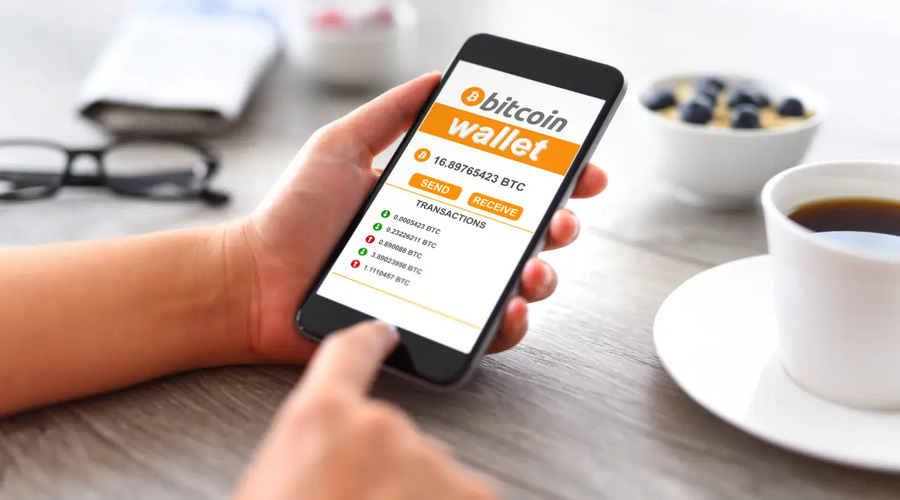Mobile crypto wallets are digital wallets that allow users to store, send, and receive cryptocurrencies on their mobile devices. While mobile wallets offer many benefits, they also come with risks that users should be aware of. In this article, we will explore the benefits and risks of using a mobile crypto wallet.
Benefits of Using a Mobile Crypto Wallet

1. Convenience
Mobile crypto wallets offer the convenience of accessing cryptocurrencies on the go. Users can easily send and receive cryptocurrencies from anywhere, as long as they have an internet connection. This makes mobile wallets a popular choice for users who need to make quick transactions.
2. Easy to Use
Mobile crypto wallets are usually designed to be user-friendly and easy to use, even for beginners. Most mobile wallets have a simple interface that allows users to manage their cryptocurrencies without any technical knowledge.
3. Portability
Mobile crypto wallets are portable and can be easily carried around in a user’s pocket or bag. This makes it easy for users to access their cryptocurrencies wherever they go, without having to carry around a bulky hardware wallet.
Risks of Using a Mobile Crypto Wallet
1. Security Risks
Mobile crypto wallets are vulnerable to security risks, such as malware attacks and hacking attempts. If a user’s mobile device is infected with malware or is hacked, their cryptocurrencies may be stolen or compromised. It is essential for users to follow best practices for mobile device security, such as using strong passwords, enabling two-factor authentication, and keeping their mobile device updated with the latest security patches.
2. Third-Party Risk
When using a mobile crypto wallet, users are exposed to third-party risk. Users have to trust the wallet provider to keep their cryptocurrencies safe, which means that they are dependent on the security measures implemented by the provider. If the provider is hacked or goes bankrupt, users may lose their cryptocurrencies.
3. Limited Control
When using a mobile crypto wallet, users have limited control over their cryptocurrencies. The wallet provider manages the cryptocurrencies on behalf of the users, which means that users have to trust the provider to keep their cryptocurrencies safe. Users cannot access their cryptocurrencies without the permission of the provider.
Best Practices for Using a Mobile Crypto Wallet
To reduce the risks associated with using a mobile crypto wallet, here are some best practices that users should follow:
1. Choose a Reliable Wallet Provider
Users should research the wallet provider and ensure that they have a good reputation in the industry. Users should look for reviews and feedback from other users, as well as information on the provider’s security measures and customer support.
2. Use Strong Passwords and Two-Factor Authentication
Users should use strong passwords and enable two-factor authentication to enhance the security of their mobile device and wallet.
3. Keep the Mobile Device Updated
Users should keep their mobile device updated with the latest security patches and software updates to reduce the risk of malware and hacking attempts.
How to Choose a Mobile Crypto Wallet
Choosing a reliable mobile crypto wallet is crucial to ensure the safety of your cryptocurrencies. With so many wallet options available, it can be challenging to know which one to choose. Here are some factors to consider when choosing a mobile crypto wallet:
Security
Security should be the top priority when choosing a mobile crypto wallet. Users should choose a wallet that offers robust security features, such as encryption, two-factor authentication, and biometric authentication. The wallet should also have a good reputation in the industry and have a track record of keeping its users’ cryptocurrencies safe.
Compatibility
Users should choose a mobile crypto wallet that is compatible with the cryptocurrencies they want to store. Not all wallets support all cryptocurrencies, so it is essential to research which wallets support the cryptocurrencies you want to store.
User Interface
The user interface of the wallet should be user-friendly and easy to use, even for beginners. The wallet should allow users to manage their cryptocurrencies easily and provide access to all the features and functionalities of the cryptocurrency ecosystem.
Customer Support
Users should choose a mobile crypto wallet that offers reliable customer support. The wallet provider should have a customer support team that is available 24/7 to assist users with their inquiries and concerns.
Fees
Users should consider the fees associated with using the mobile crypto wallet. Some wallet providers charge fees for deposits, withdrawals, and transactions. Users should compare the fees of different wallet providers and choose the one that offers the best value for their money.
How to Use a Mobile Crypto Wallet
Once a user has chosen a mobile crypto wallet, they need to know how to use it properly. Here are some steps for using a mobile crypto wallet:
Step 1: Download and Install the Wallet
Users need to download and install the mobile crypto wallet on their mobile device. The wallet can usually be downloaded from the App Store or Google Play Store.
Step 2: Create a Wallet
Users need to create a wallet by following the prompts provided by the wallet provider. This typically involves creating a username and password and backing up the wallet’s recovery phrase.
Step 3: Add Cryptocurrencies
Users can add cryptocurrencies to their wallet by following the instructions provided by the wallet provider. This typically involves scanning a QR code or entering a wallet address.
Step 4: Send and Receive Cryptocurrencies
Users can send and receive cryptocurrencies by following the instructions provided by the wallet provider. This typically involves scanning a QR code or entering a wallet address.
Tips for Securing Your Mobile Crypto Wallet
Mobile crypto wallets are vulnerable to security risks, such as hacking attempts and malware attacks. To ensure the safety of your cryptocurrencies, it is essential to follow best practices for mobile device security. Here are some tips for securing your mobile crypto wallet:
Use Strong Passwords
Users should use strong passwords to secure their mobile device and wallet. The password should be a combination of uppercase and lowercase letters, numbers, and symbols. Users should avoid using easily guessable passwords, such as birthdays or names.
Enable Two-Factor Authentication
Two-factor authentication adds an extra layer of security to your mobile device and wallet. Users should enable two-factor authentication to ensure that only authorized users can access their wallet.
Keep Your Mobile Device Updated
Users should keep their mobile device updated with the latest security patches and software updates. These updates often include security fixes that address vulnerabilities that could be exploited by hackers.
Use a Reliable Wallet Provider
Users should choose a wallet provider that has a good reputation in the industry and has a track record of keeping its users’ cryptocurrencies safe. Users should research the wallet provider and look for reviews and feedback from other users.
Keep Your Recovery Phrase Secure
The recovery phrase is a crucial component of your mobile crypto wallet. Users should keep their recovery phrase secure and not share it with anyone. The recovery phrase should be stored in a secure location, such as a safety deposit box or a fireproof safe.
What to Do If Your Mobile Crypto Wallet is Hacked
If a user’s mobile crypto wallet is hacked, they should take immediate action to protect their cryptocurrencies. Here are some steps to take if your mobile crypto wallet is hacked:
Step 1: Change Your Password
Users should change their password immediately to prevent further unauthorized access to their wallet.
Step 2: Contact Customer Support
Users should contact the wallet provider’s customer support team to report the hack and get assistance in securing their wallet.
Step 3: Monitor Your Transactions
Users should monitor their wallet transactions to ensure that no unauthorized transactions are made.
Step 4: Consider Moving Your Cryptocurrencies
If the hack has compromised the security of the wallet, users should consider moving their cryptocurrencies to a more secure wallet.
Types of Mobile Crypto Wallets
There are several types of mobile crypto wallets available, each with its own unique features and characteristics. Here are some of the most common types of mobile crypto wallets:
1. Hot Wallets
Hot wallets are mobile crypto wallets that are connected to the internet. They offer quick and easy access to cryptocurrencies but are vulnerable to hacking attempts and other security risks.
2. Cold Wallets
Cold wallets are mobile crypto wallets that are not connected to the internet. They offer enhanced security but are less convenient to use than hot wallets.
3. Software Wallets
Software wallets are mobile crypto wallets that are installed on a user’s mobile device. They offer a user-friendly interface and easy access to cryptocurrencies.
4. Hardware Wallets
Hardware wallets are mobile crypto wallets that are physical devices that can be connected to a mobile device. They offer enhanced security and are less vulnerable to hacking attempts and other security risks.
5. Paper Wallets
Paper wallets are a form of cold wallet that involves printing out a private key and storing it in a safe location. They offer enhanced security but are less convenient to use than other types of mobile crypto wallets.
The Future of Mobile Crypto Wallets
Mobile crypto wallets are becoming increasingly popular as more users adopt cryptocurrencies. In the future, mobile crypto wallets are likely to become even more secure and integrated with traditional financial services. Here are some potential developments in the future of mobile crypto wallets:
1. Decentralized Wallets
Decentralized wallets are mobile crypto wallets that allow users to maintain full control over their cryptocurrencies without relying on a third-party provider. They offer enhanced security and privacy.
2. Integration with Traditional Financial Services
Mobile crypto wallets are likely to become more integrated with traditional financial services, such as banks and payment processors. This integration will make it easier for users to manage their cryptocurrencies alongside their traditional financial assets.
3. Increased Security
Mobile crypto wallets are likely to become even more secure in the future, with advanced security features such as biometric authentication and multi-signature transaction
Conclusion
Securing your mobile crypto wallet is crucial to ensure the safety of your cryptocurrencies. By following best practices for mobile device security, such as using strong passwords and enabling two-factor authentication, users can reduce the risk of their wallet being hacked. If a user’s mobile crypto wallet is hacked, they should take immediate action to protect their cryptocurrencies, such as changing their password and contacting customer support. With proper precautions and knowledge, users can use mobile crypto wallets safely and securely.





